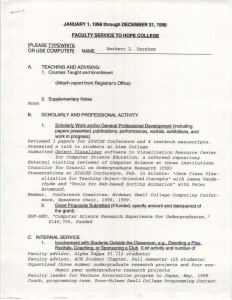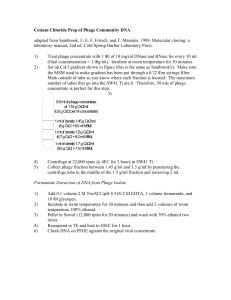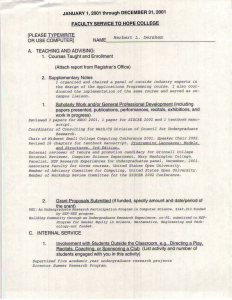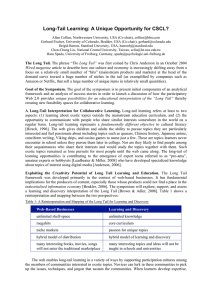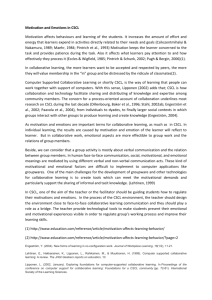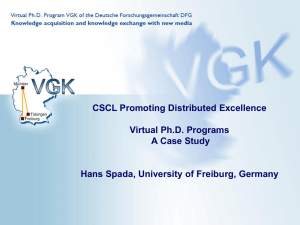Long-Tail Learning: A Unique Opportunity for CSCL?
advertisement
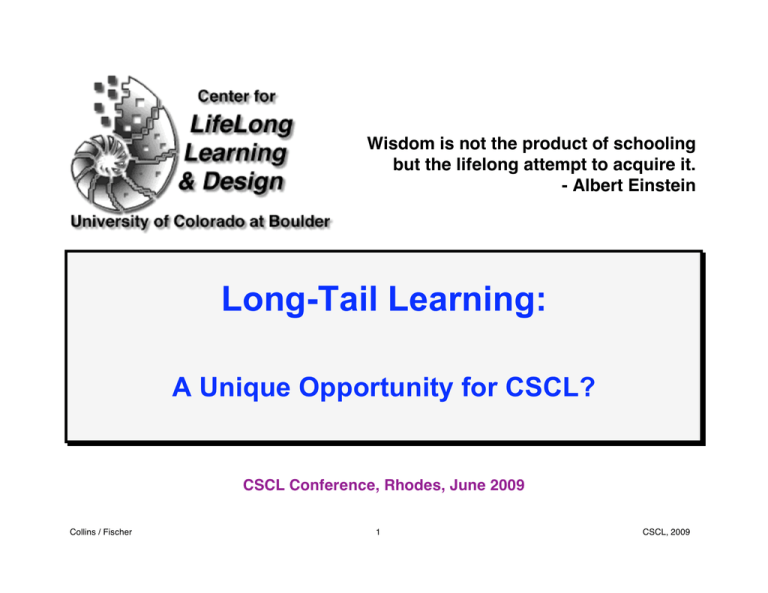
Wisdom is not the product of schooling but the lifelong attempt to acquire it. - Albert Einstein Long-Tail Learning: A Unique Opportunity for CSCL? CSCL Conference, Rhodes, June 2009 Collins / Fischer 1 CSCL, 2009 Participants Allan Collins, Northwestern University, USA (Co-chair) — Education Gerhard Fischer, CU Boulder, USA (Co-chair) — Computer Science Brigid Barron, Stanford University, USA — Education Chen-Chung Liu, National Central University, Taiwan — Networked Learning Roy Pea, Stanford University, USA — Education Hans Spada, University of Freiburg, Germany — Psychology Collins / Fischer 2 CSCL, 2009 The Origins of our Discussion Gerhard — CSCL’2007 talk “CSCL is too timid and not thinking radically enough” - by accepting too many established approaches (e.g.: a theory of human learning based solely on school learning is too limited); - by not embracing new learning opportunities (e.g.: exploiting the unique opportunities of social production in which all learners can act as active contributors in personally meaningful problems); Allan — work on a new book: - Over the course of educational history, the success of universal schooling has led us to identify learning with schooling. - The pervasiveness of schooling leads us to overlook the fact that the identification of schooling and learning has only developed in the last 150 years. Collins / Fischer 3 CSCL, 2009 The Long Tail source: Chris Anderson - Anderson, C. (2004) "The Long Tail," Wired, 12(10). - Anderson, C. (2006) The Long Tail: Why the Future of Business Is Selling Less of More, Hyperion, New York, NY. theory of the Long Tail: our culture and economy is increasingly shifting away from a focus on a relatively small number of “hits” (mainstream products and markets) at the head of the demand curve and toward a huge number of niches in the tail main opportunity — digital artifacts: computer programs, movies, books, 3D models of buildings, …. as the costs of production and distribution fall, there is less need to lump products and consumers into one-size-fits-all containers hypothesis: without the constraints of physical shelf space and other bottlenecks of distribution, narrowly-target goods and services can be as economically attractive as mainstream fare. Collins / Fischer 4 CSCL, 2009 Exploiting “Long Tail” Opportunities in Business Collins / Fischer 5 CSCL, 2009 Specific Examples of the Long Tail Collins / Fischer 6 CSCL, 2009 Rethinking and Reinventing Learning and Education from a “Long-Tail” Perspective basic beliefs: - all people are interested in something (Viking Ships, Dinosaurs, gambling, Nuremberg trials, White Rose, Castles in Northern Germany, ……) - Whatever someone’s particular interest is, there is some niche community already formed on the net that the person can join a new synergy and hybrid model: integrate head and tail of the long-tail) create richer learning environments - head — basic knowledge and skills: learning to learn, learning on demand, preparation for future learning, soft skills, digital fluency, …………… - tail — personally meaningful problems: interest and passion, self-directed learning and intrinsic motivation, local knowledge in a globalized world Collins / Fischer 7 CSCL, 2009 Stories from Collin’s / Halverson’s New Book Collins, A., & Halverson, R. (2009) “Rethinking Education in the Age of Technology: The Digital Revolution and the School” Michele Knobel tells the story of a teen whose passion is to make “animé music videos.” He participates actively in the AniméMusicVideo.org web community, where he learns programming skills from fellow members. He is gaining something of a following online as shown by the high number of YouTube views of his “Konoha Memory Book” remixed by animating music with scenes from the Japanese animé Naruto. The skills he is learning prepare him for careers in the digital and recording arts. Brigid Barron tells the story of a boy named Jamal in Bermuda, who got excited when he took a computer science course in high school. He read several books on web design, and corresponded with one of the authors over the Internet. After he completed the course, he decided to start a business called Dynamic Web Design. An adult friend offered to share his office, and so Jamal designed a web page for him. The friend thought Jamal had real talent and encouraged him to pursue his business dream. Collins / Fischer 8 CSCL, 2009 Allan Collins: How the Web Enables Long-Tail Learning Finished products might be posted on YouTube, MySpace or Epinions. When learners go to libraries, they’ll find very limited amount of information on any exotic topic. The information they may find is very likely out of date for most hot topics being investigated. Because the web is constantly evolving and actively filling up all the long tails of knowledge, it can support long-tail learning in a way not even the largest library in the world can support. Collins / Fischer 9 CSCL, 2009 A Long-Tail Interpretation for Collaborative Learning long-tail learning refers at least to two aspects - learning about exotic topics outside the mainstream education curriculum - the opportunity to communicate with people who share similar interests somewhere in the world on a regular basis long-tail learning represents a fundamentally different objective to cultural literacy (Hirsch), No Child Left Behind, …. the participatory Web 2.0 provides unique possibilities for an educational interpretation of the “Long Tail” thereby creating new feasibility spaces for collaborative learning Collins / Fischer 10 CSCL, 2009 A Reinterpretation of the Long Tail for Collaborative Learning Web-Based Businesses Learning and Discovery unlimited shelf-space unlimited knowledge megahits core curriculum niche markets passion for unique topics hybrid model of distribution hybrid model of learning and discovery many interesting books, movies, songs many interesting topics and ideas will not will not enter the traditional be taught in schools and universities marketplace Collins / Fischer 11 CSCL, 2009 Questions to be Explored and Debated How can we envision a productive synergy between the head and the tail and create mechanisms to support and exploit this synergy? How can the passion associated with topics from the tail be integrated with important basic knowledge and skills from the head that they successfully complement each other? Do we want to keep requiring everyone to learn the same thing in school rather than pursuing their deep interests? which support can be provided for letting people pursue their deep interest? Do we want to keep extending the years of schooling to encompass the expanding knowledge base? Collins / Fischer 12 CSCL, 2009
